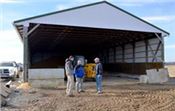|
Alternative Grain Storage Structures Help Kentucky Farmers Navigate Tight Times

UK's Brad Hagan, left, and Sam McNeill talk with Union County farmer Dan
Hendrickson outside of his temporary grain storage structure.
Photo courtesy Katie Pratt, UK Agricultural Communications
MORGANFIELD, KY.
As Kentucky farmers like Brian Shouse and Dan Hendrickson in Union County watched their yield monitors return high numbers during harvest, they knew they would have to figure out somewhere to store this abundance of grain.
This was the second year of record or near-record breaking corn yields in Kentucky and many parts of the nation. Couple these yields with slim profit margins and limited marketing opportunities, and that created a situation where many farmers in Kentucky and beyond needed to store more grain than their existing bins could hold.
“We’ve gotten into an environment where we have a lot of surplus and a lot of stocks, and basis has not appreciated as much as in the past,” said Todd Davis, agricultural economist with the University of Kentucky College of Agriculture, Food and Environment. “It’s important for farmers to try to find low-cost storage methods to increase their likelihood of being profitable.”
For many farmers, including Shouse and Hendrickson, temporary alternative storage structures have been the answer, as they are readily available and economical. Shouse decided to use grain bags and invested in a bagger and debagger with a neighboring farm.
“We have plans to expand our existing facility, but when we realized our crop yield potential was better than we had projected, we didn’t have time to complete extra storage here with grain bins,” he said. “We chose a temporary route to add flexibility to be able to store those bushels on the farm and gain better marketing opportunities with this investment. So far, we’ve been satisfied with it.”
College specialists and agents with the UK Cooperative Extension Service worked with farmers as they navigated the decision-making process regarding these structures. This past fall, Brad Hagan, Union County agriculture and natural resources extension agent, answered several calls from farmers in his county, including Hendrickson, about the amount of grain they could put in various temporary storage structures. As calls came in to his office, Hagan connected farmers with UK agricultural engineer Sam McNeill and invited him to visit with farmers in his county.
McNeill developed several online decision aids for farmers, which are available on the UK Department of Biosystems and Agricultural Engineering website at https://www.uky.edu/bae/grain-and-energy-calculators. These calculators and spreadsheets help producers figure out the amount of grain various sizes and types of structures can hold.
“In Kentucky, we have 15 million more bushels held on-farm compared to this time last year. Part of that is because of low prices, but another reason is because farmers are using more alternative storage structures,” McNeill said. “We have several things on our website to help farmers calculate the holding capacity. We also have recently updated a handbook, The Grain Drying, Storage and Handling Handbook that can help farmers with planning and laying out various facilities.”
Hendrickson retrofitted a former cattle facility, adding wall strength and aeration fans and enclosing three sides of the building. He used McNeill’s calculators to get started.
“We were curious to see where in the ball park we could be on how much grain we could store in there,” he said.
Once he is finished storing the grain, Hendrickson sees additional uses for the building including equipment storage, fertilizer storage or maybe even a facility for a 4-H livestock project. He may also store grain in it again if faced with a similar situation.
Both Shouse and Hendrickson agree their structures have worked well for them this winter.
“In years where you have higher yields and productivity, I think this is a very flexible way to temporarily store grain,” Shouse said. ∆
|
|